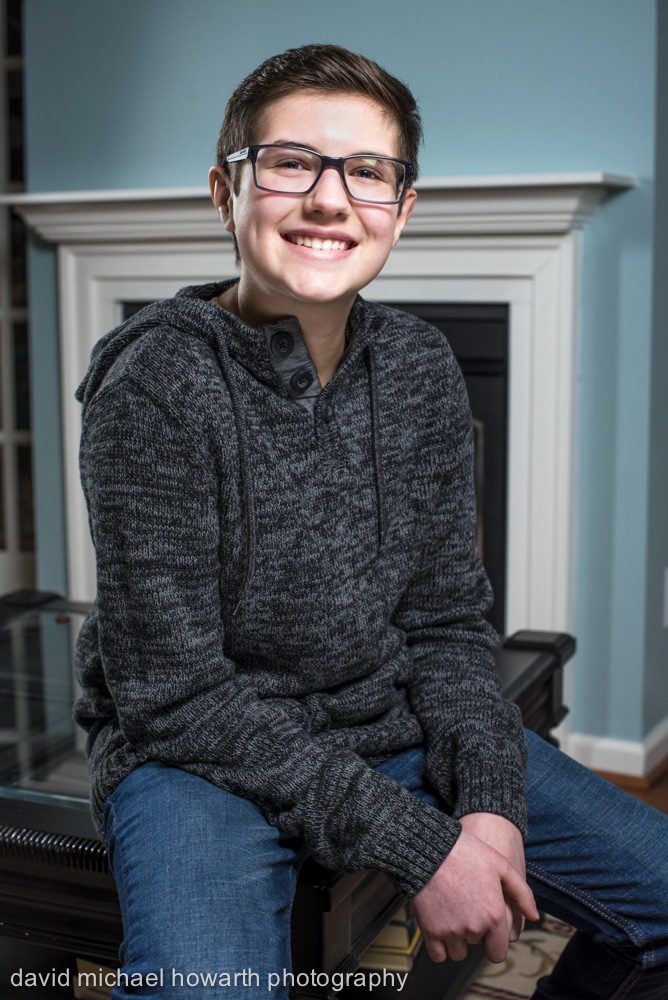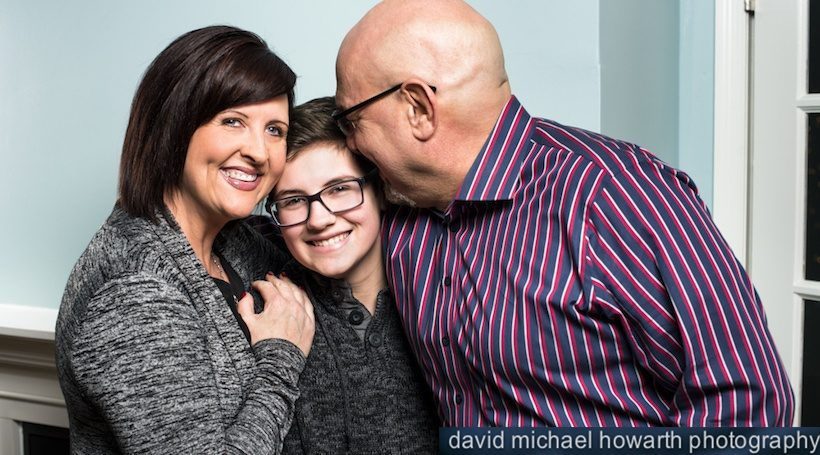A haircut changed Mason Catrambone’s life. Today he is an ebullient, articulate 14-year-old boy from Williamstown, but on that day nearly two years ago, he was Madelyn; and Madelyn had thick, shoulder-length brown hair.
 Mason came out to his parents, Frank Catrambone and Annmarie Kita, as transgender last May, on his 14th birthday. It was the next step in a journey that began when he left the salon with his hair cut close to the scalp.
Mason came out to his parents, Frank Catrambone and Annmarie Kita, as transgender last May, on his 14th birthday. It was the next step in a journey that began when he left the salon with his hair cut close to the scalp.
“There was always something kind of off with how I felt about myself,” Mason says. “I knew there was something different, and I knew what being transgender was, but I didn’t think it applied to me. There was a point when I thought I was bisexual or a lesbian; it’s much easier to come to that conclusion, because you’re still you, you’re just attracted to the same sex. It wasn’t until I cut my hair that I was like, ‘Oh. This is about being masculine.’ When I looked in the mirror it was like it wasn’t me, but in a really good way.”
Mason, who’d been treated for anxiety and depression since childhood, experienced an internal battle in the months that followed.
“It was a whole spiral of, ‘I don’t want to be this,’ because I know how hard life has been for other transgender people,” he says. “But when I was out with friends, if people mistook me for a guy I’d think, ‘If I was alone, I wouldn’t correct them.’”
Over the next two years, Mason realized he is indeed a FTM (female-to-male) transgender person. Though he was born biologically female, he identifies as a male. Transgender is an umbrella term that applies to people whose internal sense of gender does not match the sex – the chromosomes, hormones, reproductive organs and secondary sex characteristics – they were born with.
A study published in 2016 by the Williams Institute at the UCLA School of Law places the number of transgender adults in the United States at 1.4 million, approximately 0.6 percent of the population. The study also estimates that there are approximately 150,000 transgender youth ages 13-17.
While some transgender people choose to undergo hormone treatments and surgeries to change their internal and external physical characteristics, others are content to use their names, pronouns, outward appearance and social cues to express their true gender.
Linda Hawkins, PhD, founder and co-director of the Gender and Sexuality Development Clinic at the Children’s Hospital of Philadelphia, says it’s important to understand the goal of a transition is different for each individual.
“Folks come in thinking transgender means one thing, or transitioning means one thing,” Hawkins says. “YouTube and some online resources make it seem like there are two ways to transition, and that’s medically taking estrogen or medically taking testosterone. In fact, each individual has their own gender goals and their own journey. While we once thought there were only two categories – male and female – we’re starting to understand there’s quite a spectrum between those two perceivably opposite poles.”
The clinic is the only one of its kind in the region, and Hawkins says some of the nearly 450 families it serves come from as far away as the Carolinas for treatment. Hawkins and her team work with each patient to determine their goals and connect them with the resources – social, emotional and medical – to help them get there.
“An individual’s gender goals could include wanting to have a specific name and pronoun, different clothing and haircuts, and that could be as far as someone would like to go,” Hawkins says. “Others may want to add medicines and surgeries. It’s important to listen to exactly who the kid is and how they want to be in the world.”
Though he shared his struggle with friends, Mason says he was petrified to come out to his parents as transgender and didn’t think he’d ever have the courage to be honest with them.
“I thought if anyone was going to be weird about it, it’d be my dad,” Mason says.
“He’s older, and more traditional, and I just didn’t think that would fly. My parents were supportive when I came out as bisexual – even though it turns out I’m not – but I thought being transgender is like a whole other level. They went through a period of mourning Madelyn, which I expected, and it’s really not nice to hear your mom cry, but I knew that was something they’d have to deal with. They lost a daughter, but gained a son.”
Mason’s father, Frank Catrambone, says the emotions he felt in the wake of Mason’s announcement that he was not, in fact, Frank’s daughter, but his youngest son, ran the gamut from shock and sadness to guilt and confusion.
“There’s guilt, like, ‘Am I responsible? Did I do something?’ There’s mourning for the loss of our daughter,” Frank says. “At first I didn’t understand what being transgender meant. I had to educate myself to understand what Mason was talking about. I’m still learning and still trying to wrap my mind around it.”
Frank poured himself into research, reading essays by parents of transgender children and watching videos online. During one video, he says, he hit an abrupt turning point.
“It was when I saw the incredibly high suicide rate of transgender children who don’t have the support of their parents and family,” Frank says. “That changed everything.”
According to studies by the Williams Institute and the American Foundation for Suicide Prevention, 4.6 percent of the overall U.S. population has attempted suicide; in comparison, 41 percent of transgender people nationwide have tried to take their own lives at least once.
“A father in one of the videos I watched said, ‘I’d rather have a live son than a dead daughter,’” Frank says. “That’s it. As shocking as it is, when it comes down to that, there’s no choice to make. None.”
Many transgender people suffer from severe anxiety and depression, often brought on or exacerbated by a condition called gender dysphoria. While being transgender is not in any way classified as a mental disorder, gender dysphoria is.
“Dysphoria is discomfort with some aspects of one’s body,” Hawkins says. “This is clinical distress that goes far beyond anxiety around unwanted erections or not wanting to go to school the first few days of your period. This is a level of distress that can lead to somebody not wanting to be alive.”
By his 14th birthday, Mason was suffering from dysphoria, and fears about his developing female body began to outweigh the fear of his parents’ reaction.
“A huge thing that pushed me to come out to my mom and dad that night was because I knew a major point in puberty was coming soon,” he says.
“It was going to happen, and things were going to get bigger, and that was terrifying. I thought, ‘God, I don’t want that.’ It’s a huge fear for pretty much all transgender males, that once that happens there’s no reversing it and you’ll always look like a woman. We know now it’s better if you start hormones before that.”
Hawkins has been working with transgender people for nearly two decades, and she says growing comfort with the spectrum of gender and sexuality means she’s seeing first-time patients much younger.
“Because as a society we’re growing in our overarching comfort with this, we’re opening up a dialogue that’s helping people connect the dots around gender in ways that are leaps and bounds from where we were 10, or even five years ago,” Hawkins says.
“Parents are reaching out with younger children and becoming aware of the fact that gender identity development actually happens between ages 3 and 5. We don’t need to wait for a child to be in significant distress.”
Hawkins attributes much of the developing national dialogue to increased representation of transgender people in entertainment. Transgender actress Laverne Cox stars in Netflix’s “Orange is the New Black,” actor Jeffrey Tambor plays a transgender woman on Amazon’s “Transparent” and former Olympian Caitlyn Jenner dominated headlines last year for going public with her transition. Jazz Jennings, a 15-year-old transgender girl, has a reality show on TLC called “I Am Jazz,” and last summer, Cherokee High School graduate Matt Dawkins was featured in an episode of ESPN’s E:60 about his transition. Last September, ABC’s popular sitcom “Modern Family” featured the first transgender child actor to appear in a primetime TV series.
“The more articles are printed and the more TV shows there are, the more people will – I hope – become educated and aware that this is not a choice,” Frank says. “I’ve heard people say, ‘It’s a fad,’ or, ‘It’s just because of what kids are exposed to on TV.’ What child in their right mind would choose this? I try not to read the negative stuff that’s out there, but I do sometimes, and it’s sad because people just don’t understand.”
Despite growing awareness and acceptance, Hawkins says the transgender community remains marginalized and at risk for discrimination and violence.
Even when parents are supportive, she says, many transgender young people will experience harassment or discrimination at school, in a church community or in their neighborhood.
The National Center for Transgender Equality reports that 78 percent of transgender students in grades K-12 experienced harassment and 35 percent have experienced physical assault.
“At least a third of the children who attend [The Gender and Sexuality Development Clinic at CHOP] do not attend school because of bullying and verbal or physical violence,” Hawkins says. “Having a young person decide they can’t be in school creates a domino effect of lost friendships, lost connection and isolation with far-reaching negative impacts.”
Mason says he was lucky to receive the support of his friends, parents and extended family, but he was subjected to online abuse at the hands of strangers when his story made newspapers and TV last summer. Mason had been accepted to Camden Catholic High School in Cherry Hill as Madelyn and was later told he would not be allowed to enroll as Mason or to wear a boy’s uniform to school. His enrollment was withdrawn, and he chose to go public with the story, first published in The Philadelphia Inquirer. He also appeared alongside his parents on NBC10 news and Fox 29’s “Good Day Philadelphia.”
“With all the exposure, there was a ton of support and positive comments, but there were also people saying I should be sent to a mental hospital, or that we’re deranged. Someone said I should be killed,” Mason says.
“It was something I was prepared to hear, but it’s still not easy. My main goal in going public with the story was to let other transgender people know I’m fighting for justice – not just for me, but for them. When I’m older I’d love to speak at schools and spread love and acceptance. The best part about the whole thing is that we’ve gotten emails from people saying how much it’s helped them. That outweighs the people who think there’s something wrong with me.”
Mason attended a California-based online school for several months, but being separated from his peers was difficult for the outgoing teen. He enrolled as a freshman at Williamstown High School in December.
“I know by the end of this year I’ll be so much more comfortable with the person I’m becoming, finally comfortable with my gender and the name I call myself,” Mason says.
“Every time I say, ‘Hi, nice to meet you, I’m Mason,’ it’s a confidence boost. I get to be who I am every day, and I know I will always come home to two people who love me unconditionally. It’s amazing – all of it. It’s like finally taking a breath of fresh air.”














